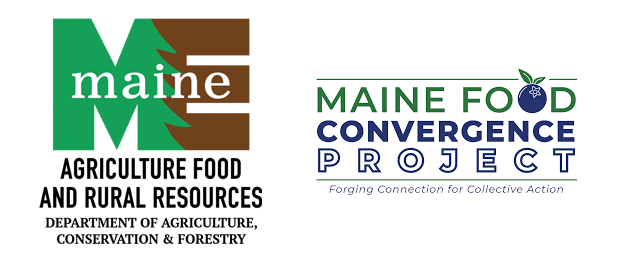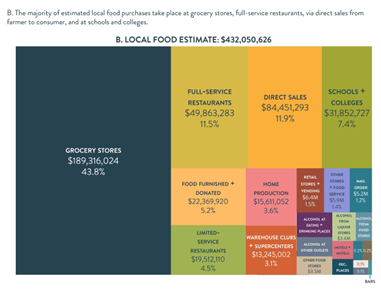|
For Immediate Release
September 10, 2024
 Click here to access Media Images for the story.
Maine Local Food Spending Insights Revealed: Significant Growth Potential in Regional Food Consumption
AUGUSTA, ME – The New England Food System Planners Partnership just released a new detailed analysis of local food spending in Maine – Local Food Count 2022. The report reveals that $432 million, or 3.4% of the state's total $12.8 billion in food, beverage, and alcohol expenditures, were directed toward local and regional products. This equates to an estimated $312 per person per year, showing that while Maine people are making strides in supporting the state’s food economy, there's room to grow.

This report defines 'local' as food grown or produced in Maine, and 'regional' is defined as food grown or produced in New England. The report reveals that spending on local products at grocery stores was estimated at $163 million (4.3% of total grocery store spending), spending via direct sales channels—farmers markets, CSAs, farm stands—was considered 100% local, as were home production (e.g., gardens) and donations. Spending on local products at full-service restaurants was estimated at $50 million (3.0% of total full-service restaurant spending), while schools and colleges accounted for $32 million (6.9%). “Food furnished and donated,” which includes food served at hospitals, prisons, and assisted living facilities, accounted for $22 million (3.9%). Accompanying the local food count is an interactive data dashboard that enables a look at the regional and state-level results
|
“The Local Food Count 2022 report clearly highlights the opportunity to increase the amount of Maine and regionally-grown and produced food consumed in our state,” commented Maine Department of Agriculture, Conservation and Forestry (DACF) Commissioner Amanda Beal. “The DACF is committed to continuing our work to enhance farm and food production infrastructure and investment, market access, food security, and more in support of getting more Maine foods onto the plates of our friends and neighbors – here in Maine and regionally.”
Maine’s collaboration with the New England Food System Planners Partnership initiative is a testament to the state’s unwavering commitment to its food economy, as outlined in the "Maine Won’t Wait" climate action plan. Under Maine Won’t Wait, Maine is working towards an ambitious goal: increasing the proportion of locally sourced food consumed in the state to 30% by 2030. With New England's largest share of farmland and fisheries, Maine plays a pivotal role in reaching this regional target.
“Since launching Maine Won’t Wait in 2020, the state has initiated a number of strategies aimed at bolstering local food consumption and production,” continued Beal.
Some key achievements:
-
Infrastructure Investment: Through its Agricultural Infrastructure Investment Program (AIIP), the DACF made more than $19 million in investments in processing capacity on-farm and off-farm through 64 awards across meat, dairy, grain, vegetable, and fruit product categories and in farms and businesses at various operating scales in order to strengthen the local supply. High-priority projects across the state have expanded storage, refrigeration, and processing equipment and supported diverse activities, including grain drying, potato storage, and meat processing in areas like Wilton, Turner, Gardiner, and Crystal, and large-scale broccoli production and freezing in Caribou. Other investments include dairy production, blueberry processing, and mixed vegetable operations.
-
Economic Empowerment: Maine farmers participating in the Local Food Purchase Assistance program, administered by DACF, have earned nearly $2 million by supplying locally grown foods to the emergency and charitable food system.
-
Collaborative Efforts: DACF annually supports the Good Shepherd Food Bank’s "Mainers Feeding Mainers" program, investing $1 million yearly to procure Maine-grown food for those in need.
-
Federal Support: The USDA’s Agricultural Marketing Service has awarded $2.6 million to DACF to establish the "Maine Food for Maine People" project, bolstering support for underserved producers and aggregators.
-
Sustainable Practices: The Maine Healthy Soils Program is establishing financial and technical assistance to support farmers in enhancing their healthy soil practices.
-
Access to Local Foods: DACF administers Real Maine, the state’s official agriculture and agritourism promotions program, and Maine Senior Farm Share Program, which provides eligible low-income seniors a $50 share of first-quality, fresh, local produce at no cost directly from 100 participating Maine farmers during the growing season. DACF is exploring new partnerships with farmers' markets to improve access for Maine’s older adults.
-
Community Impact: The Ending Hunger Corps, an AmeriCorps VISTA program sponsored by DACF, has significantly increased food security for over 150,000 Maine people.
-
Future Initiatives: Maine's USDA-funded Resilient Food Systems Infrastructure program will provide grants to key players in the supply chain, while the Farmer Drought Relief Program will help farmers develop sustainable agricultural water sources.
-
Farmland Protection: The Working Farmland Access Protection Program secures farmland access and works to enhance future farm viability. The Farms for the Future program provides farms with business planning assistance and investment support.
-
Support for Dairies: The Maine Dairy Tier Program and the Dairy Task Force offer crucial resources and support for dairies and work to develop markets for Maine's dairy products.
Maine’s progress exemplifies the state’s dedication to building a resilient, sustainable, and locally focused food system that benefits the economy and our communities.
Residents and Business Owners Asked to Choose Local and Regional Food!
Access to local and regional foods here in Maine has been growing thanks to the hard work and dedication of many chefs, retailers, institutions, and customers who seek out foods produced close to home - but we can do more! Maine grocery stores are encouraged to source and promote local and regional food, highlighting products with signage and labeling on shelves and coolers. Restaurant owners and chefs are encouraged to purchase more local products and promote local farms and food producers on their menus. Residents and visitors can help bolster our local food economy by choosing local and regional food when purchasing, keeping our dollars closer to home.
The Need to Capture Future Local Food Counts
This data serves as a baseline for future assessments, with subsequent counts planned for 2025 and 2030. The report also identifies gaps in current data, such as specific product details, and suggests areas for improvement in data collection and local food system support.
"Local Food Counts gives us baseline data and goals for developing our local food infrastructure and marketing to promote and protect the health of Maine’s people and economy now and in the future." - Annie Doran, Maine Food Convergence Project Director.
Goal: 30% Consumption of Regional Food Products by 2030
The local food count data collection is part of a greater effort to reach a regional goal of producing and consuming 30% of New England’s food needs in the region by 2030. In 2023, the New England Food System Planners Partnership, a collaboration between seven state-level organizations, six state agricultural, economic, and environmental department representatives, and Food Solutions New England (FSNE), released A Regional Approach to Food System Resilience. The research explores the opportunities and needs along the food supply chain in New England and highlights the land, sea, and labor needs of the region, consumer purchase metrics, distribution trends, and population projections that will impact the region’s ability to feed itself in the coming years.
Focus Maine and Third Sector New England, Inc., made funding for the 2022 local food counts project possible. Maine partners include the Independent Retailers Association and Maine Grocers and Food Producers Association (MGFPA), with support from the Maine Department of Agriculture, Conservation & Forestry.
About the New England Food System Planners Partnership
The New England Food System Planners Partnership (NEFSPP) is a collaboration among seven state-level food system organizations, six state agricultural, economic and environmental department representatives, and Food Solutions New England (FSNE), a regional network that unites the food system community. Together, they are mobilizing regional networks to impact local and regional food supply chains and strengthen and grow the New England regional food system. The Partnership disseminates information on trends, challenges, and opportunities to hundreds of groups across the region that connect with our individual state initiatives. The Partnership is fiscally sponsored by the Vermont Sustainable Jobs Fund.
About the Maine Department of Agriculture, Conservation and Forestry
The DACF is the State of Maine’s support center for many land-based, natural resource interests. The Department balances and develops the state’s various land-based, natural resources, including Maine agriculture, forests, outdoor recreation, and public access. The Division of Agricultural Resource Development (ARD) is responsible for developing and implementing programs and policies to ensure that agricultural businesses remain profitable and sustainable. Programs like Real Maine focus on business development, market promotion, education, and regulation to ensure that agricultural practices are economically and environmentally sound.
About Maine Food Convergence Project
The Maine Food Convergence Project is a collaborative effort involving various network partners, bringing together organizations, networks, groups, and individuals to catalyze collective action toward creating a thriving, equitable, just, and regenerative Maine food system. The project is fiscally sponsored by Third Sector New England, Inc. (TSNE). Before Maine Food Strategy, a network partner of MFCP, sunsetted, Project Director Tanya Swain led this research in Maine.
###
|
